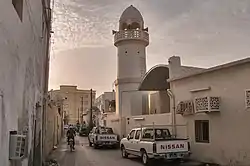Najma (Doha)
Najma (Arabic: نجمة) is a district in Qatar, located in the municipality of Doha.[1] Considered to be one of Doha's older districts, the bulk of Najma's commercial and office spaces are located along the arterial roads of Airport Street, C Ring Road and B Ring Road.[2]
Najma
نجمة | |
|---|---|
District | |
 Sikkat Al Thurayya Street in Al Najma | |
 Najma  Najma | |
| Coordinates: 25.269°N 51.541°E | |
| Country | |
| Municipality | Ad-Dawhah |
| Zone | Zone 26 |
| District no. | 23 |
| Area | |
| • Total | 1.1 km2 (0.4 sq mi) |
| Population | |
| • Total | 24,763 |
| • Density | 23,000/km2 (58,000/sq mi) |
Landmarks
- Al Meera Supercenter on Airport Street.[3]
- Al Khazem Souq on Al Mansoura Street.[3]
- Souq Al Haraj on Al Mansoura Street.[3]
- Labour Inspection Department of the Ministry of Labour on C Ring Road.[3]
- Qatar Petroleum office on C Ring Road.[3]
- Cinema Complex with Gulf Cinema and Doha Cinema on C Ring Road.[3]
- Gulf Snooker Center on Al Khalidiya Street.[3]
Transport
Mowasalat is the official transport company in Qatar and serves the community through its operation of public bus routes. Najma is served by three bus lines, all of which depart from Al Ghanim Bus Station. Route 10 has stops at Najma and Al Mansoura and a terminus at Al Thumama at Bus Stop 5, running at a frequency of every 30 minutes on all days of the week. Route 11 has stops at Al Najma, Lulu Hyper Market, and Old Airport and a terminus at Al Thumama near the Supreme Education Council, running at frequency of every 20 minutes on all days of the week. Finally, route 49 is a circular route with stops at Hamad Hospital, C-Ring Road, Al Najma and D-Ring Road and a terminus at Al Ghanim Bus Station, running at a frequency of every 30 minutes on all days of the week.[4][5]
Major roads that run through the district are Airport Street, Najma Street, B Ring Road, C Ring Road, and Al Mansoura Street.[6]
Qatar National Master Plan
The Qatar National Master Plan (QNMP) is described as a "spatial representation of the Qatar National Vision 2030".[7] As part of the QNMP's Urban Centre plan, which aims to implement development strategies in 28 central hubs that will serve their surrounding communities, Najma has been designated a District Centre, which is the lowest designation.[8]
Najma District Centre includes sections of four different zones located at the crossing of B Ring Road and Airport Street: Zone 15 (Ad Dawhah al Jadidah), Zone 16 (Old Al Ghanim), Zone 26 (Najma) and Zone 27 (Umm Ghuwailina). Somewhere from 10,000 to 15,000 residents will be situated in the District Centre, thus the plan emphasizes the construction of more high density apartment buildings. The Centre will be served by the Old Airport Metro Station on Airport Street, which is part of the Doha Metro's Red Line, and plans are in place to develop the pedestrian infrastructure around the metro station. Other objectives of the plan are to increase public services in the Najma area and to preserve the historic architecture of the area.[2]
Demographics

As of the 2010 census, the district comprised 5,936 housing units[9] and 1,012 establishments.[10] There were 24,763 people living in the district, of which 73% were male and 27% were female. Out of the 24,763 inhabitants, 83% were 20 years of age or older and 17% were under the age of 20. The literacy rate stood at 96.5%.[11]
Employed persons made up 74% of the total population. Females accounted for 14% of the working population, while males accounted for 86% of the working population.[11]
| Year | Population |
|---|---|
| 1986[12] | 9,141 |
| 1997[13] | 10,826 |
| 2004[14] | 16,697 |
| 2010[1] | 24,763 |
Education
The following school is located in Najma:
| Name of School | Curriculum | Grade | Genders | Official Website | Ref |
|---|---|---|---|---|---|
| Ahmed Bin Hanbal Independent Secondary School for Boys | Independent | Secondary | Male-only | N/A | [15] |
References
- "2010 population census" (PDF). Qatar Statistics Authority. Archived from the original (PDF) on 2 April 2015. Retrieved 29 June 2015.
- "Centre Plans and Zoning Regulations" (PDF). Ministry of Municipality and Environment. pp. 103–110. Retrieved 11 November 2019.
- "Qatar Landmarks". Ministry of Development Planning and Statistics. Retrieved 8 January 2019.
- "Route Maps". Qatar Transit Guide. Retrieved 21 January 2019.
- "Qatar Public Transport Program (QPTP)". Ministry of Transport and Communications. Retrieved 21 January 2019.
- "Index map of Qatar". ArcGIS.com. Retrieved 25 August 2019.
- "About Qatar National Master Plan". Ministry of Municipality and Environment. Retrieved 11 November 2019.
- "About the Centre Plans". Ministry of Municipality and Environment. Retrieved 11 November 2019.
- "Housing units, by type of unit and zone (April 2010)" (PDF). Qatar Statistics Authority. Archived from the original (PDF) on 8 July 2015. Retrieved 7 August 2015.
- "Establishments by status of establishment and zone (April 2010)" (PDF). Qatar Statistics Authority. Archived from the original (PDF) on 8 July 2015. Retrieved 7 August 2015.
- "Geo Statistics Application". Ministry of Development Planning and Statistics. Archived from the original on 11 September 2012. Retrieved 7 August 2015.
- "1986 population census" (PDF). Qatar Statistics Authority. Archived from the original (PDF) on 3 July 2015. Retrieved 2 July 2015.
- "1997 population census" (PDF). Qatar Statistics Authority. Archived from the original (PDF) on 29 May 2015. Retrieved 2 July 2015.
- "2004 population census". Qatar Statistics Authority. Archived from the original on 24 September 2015. Retrieved 1 July 2015.
- "Ahmad Bin Hanbal Secondary Independent Boys". Supreme Education Council. Archived from the original on 24 September 2015. Retrieved 18 July 2015.